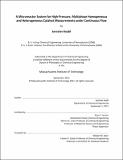| dc.contributor.advisor | Klavs F. Jensen. | en_US |
| dc.contributor.author | Keybl, Jaroslav | en_US |
| dc.contributor.other | Massachusetts Institute of Technology. Dept. of Chemical Engineering. | en_US |
| dc.date.accessioned | 2012-04-26T18:49:53Z | |
| dc.date.available | 2012-04-26T18:49:53Z | |
| dc.date.copyright | 2011 | en_US |
| dc.date.issued | 2011 | en_US |
| dc.identifier.uri | http://hdl.handle.net/1721.1/70399 | |
| dc.description | Thesis (Ph. D.)--Massachusetts Institute of Technology, Dept. of Chemical Engineering, 2011. | en_US |
| dc.description | Cataloged from student-submitted PDF version of thesis. | en_US |
| dc.description | Includes bibliographical references (p. 194-206). | en_US |
| dc.description.abstract | The shift towards biomass and lower quality fossil fuel feedstocks will require new conversion approaches. Catalysis will be critical in the processing of these new feedstocks. By studying catalysis at industrially relevant conditions, it may be possible to reduce the time and cost of developing new catalyst systems. Microreactors enable the study of multiphase catalyst systems at pressures that were previously difficult to attain on the laboratory scale. The reduced length scales, characteristic of microchemical systems, provide additional benefits such as enhanced heat and mass transfer and a reduction of hazardous waste. The improved heat and mass transfer allow for kinetics to be probed at isothermal conditions in the absence of complicating mass transfer effects. A high-pressure microreactor system for catalyst study was designed, fabricated, and tested. The system allows for the multiphase study of homogenously and heterogeneously catalyzed systems, with a unique reactor designed for each application. A multicomponent gas phase is delivered simultaneously with a liquid stream, resulting in regular segmented (slug) flow. The isobaric system is operated at pressures of up to 100 bar. Gas and liquid flow rates, and therefore residence time, are specified independently of pressure. The system is capable of being operated at temperatures of up to 350°C and residence times of up to 15 minutes. Inline analysis, using an attenuated total reflection FTIR flow cell, and sample collection for offline analysis can be performed simultaneously. Both homogeneous and heterogeneous catalysis were demonstrated in the high-pressure system. A kinetic expression was derived for the homogeneous hydroformylation of terminal alkenes, catalyzed by Wilkinson's catalyst. The empirical reaction orders for the dependence on catalyst, hydrogen, and carbon monoxide were determined, along with the activation energy and pre-exponential factor. These results were then reconciled with a mechanistic model. The hydrogenation of cyclohexene over platinum catalysts was chosen to demonstrate the performance of the heterogeneous reactor. This reaction proceeded rapidly allowing mass transfer to be characterized in the microreactor. Observed mass transfer rates were two orders of magnitude higher than in traditional systems. | en_US |
| dc.description.statementofresponsibility | by Jaroslav Keybl. | en_US |
| dc.format.extent | 216 p. | en_US |
| dc.language.iso | eng | en_US |
| dc.publisher | Massachusetts Institute of Technology | en_US |
| dc.rights | M.I.T. theses are protected by
copyright. They may be viewed from this source for any purpose, but
reproduction or distribution in any format is prohibited without written
permission. See provided URL for inquiries about permission. | en_US |
| dc.rights.uri | http://dspace.mit.edu/handle/1721.1/7582 | en_US |
| dc.subject | Chemical Engineering. | en_US |
| dc.title | A microreactor system for high-pressure, multiphase homogeneous and heterogeneous catalyst measurements under continuous flow | en_US |
| dc.type | Thesis | en_US |
| dc.description.degree | Ph.D. | en_US |
| dc.contributor.department | Massachusetts Institute of Technology. Department of Chemical Engineering | |
| dc.identifier.oclc | 784091596 | en_US |
